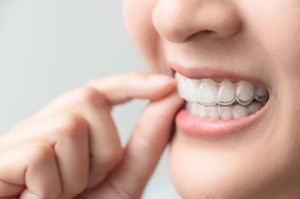
When straightening your smile with Invisalign, you will wear your aligners for most of the day. Some people think that since the aligners completely cover the teeth, they will not have to worry about cavities during their treatment. But is that really the case? Here’s what you need to know about tooth decay during the Invisalign process and the steps you can take to protect your smile.
Can Cavities Form During the Invisalign Process?
Simply put, yes; it is completely possible to still get cavities even when you’re in the middle of the Invisalign process. Despite staying on your teeth for at least 20 to 22 hours every day, your aligners will need to be removed whenever you eat or drink anything besides water. As such, your teeth will still regularly be exposed to food particles that can contribute to tooth decay. Furthermore, if you don’t practice proper oral hygiene, food can get trapped between your aligners and your teeth, thus raising your risk for cavities.
How Can You Avoid Cavities During Invisalign Treatment?
In order to minimize the chances of cavities occurring during the Invisalign process, be sure to follow these tips:
- Whenever you’re done eating, brush and floss thoroughly before you put your aligners back on your teeth. This will help get rid of lingering bits of food.
- Take the time to clean your Invisalign aligners by brushing them with a soft-bristled toothbrush. You should also periodically soak them in a specialized cleansing solution.
- Visit your dentist at regular intervals. Not only can they make sure that your Invisalign treatment is on track, but they can also keep an eye out for any oral health problems that might be forming.
What Happens If You Get a Cavity During Invisalign Treatment?
If signs of decay are found during the Invisalign process, your dentist will make treating it a priority. This often involves placing a filling or another type of dental restoration. Bear in mind that this can potentially change the way your aligners fit, especially if you end up needing a dental crown. Nevertheless, it’s always best to treat cavities right away than it is to allow them to grow more severe over time.
Regardless of whether you’re currently in the middle of Invisalign treatment or not, it is always worth going the extra mile to protect your smile from cavities. By taking the right steps to prevent tooth decay, you’ll be much more likely to enjoy a smooth, complication-free orthodontic process.
About the Author
Dr. Andrew R. Glynn studied dentistry at the Ohio State University and has served as a dentist in the Air Force. He has completed continuing education regarding clear aligners and various other subjects. At Glynn Dental of Reynoldsburg, he has helped many patients achieve straighter smiles thanks to Invisalign. To schedule a consultation with Dr. Glynn, visit his website or call (614) 864-4618.
